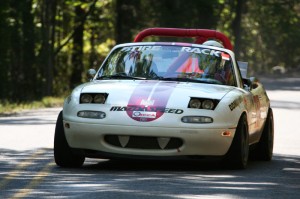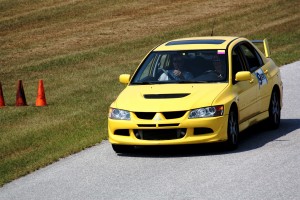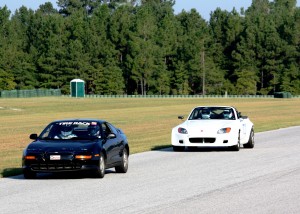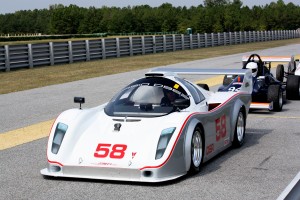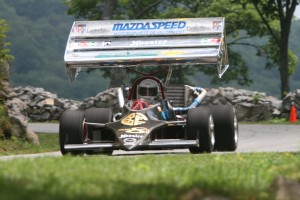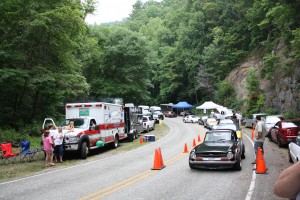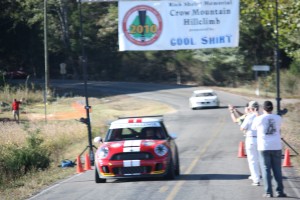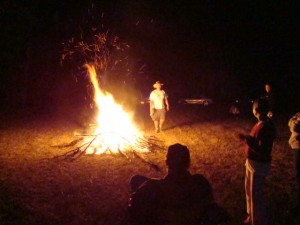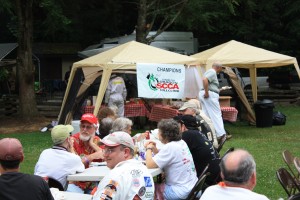Hillclimbing – Life going UP HILL!
Hillclimbing – Getting Started
 Motorsports has many facets. While we all enjoy our common bond of speed, air being displaced by smooth lines, the sound created when man and machine become one on asphalt, and the fellowship with others blessed with that kindred spirit, our chosen expressions of that interest vary greatly. Some enjoy the thrill of polishing to perfection for competition in a concours d’ elegance. Some enjoy a weekend of competitive autocrossing on a cone covered black lake and the pleasure of driving that same race car to work on Monday through Friday without the class and number magnets. Some thrive on the hours in the garage preparing for a weekend of road racing competition… straining every ounce of horsepower while laying down consistent laps regardless of traffic encountered. Then there are those crazy hillclimbers… and if you are interested in becoming one, this article is for you.
Motorsports has many facets. While we all enjoy our common bond of speed, air being displaced by smooth lines, the sound created when man and machine become one on asphalt, and the fellowship with others blessed with that kindred spirit, our chosen expressions of that interest vary greatly. Some enjoy the thrill of polishing to perfection for competition in a concours d’ elegance. Some enjoy a weekend of competitive autocrossing on a cone covered black lake and the pleasure of driving that same race car to work on Monday through Friday without the class and number magnets. Some thrive on the hours in the garage preparing for a weekend of road racing competition… straining every ounce of horsepower while laying down consistent laps regardless of traffic encountered. Then there are those crazy hillclimbers… and if you are interested in becoming one, this article is for you.
Why Hillclimb?
The pat answer I always give is “because down hill would be way too fast AND DANGEROUS.”
For an autocrosser, hillclimbing is taking solo to the extreme level. The pylons are still there but they are heavy and stone colored. The skills you developed as an autocrosser become vitally important as looking ahead is the difference between a good line and a tree. The feel for the car on asphalt becomes more critical as adhesion from surface grip changes with asphalt condition, change in temperature due to tree cover and the camber of turns. It is also a great benefit to have two days to tweak and tune your car and your driving lines and 15 to 20 runs to find your best time. It’s not all 4 runs within an hour.
For a road racer, hillclimbing may at first be thought of as a step back by some. Many drivers associate the term racing with “in traffic, wheel to wheel, door to door”. The road racers who have run hillclimbs come back with a changed mind. On a track, you have a set course which you practice repeatedly, again and again until you know every turn and the line to get your car through the quickest. In a race, your goal is to maintain that line for fastest laps consistently OR pass people on course while maintaining the fastest line possible and lap times. It’s repetition in learning the track and racecraft in creatively finding your way through in traffic. A hillclimb does not afford you the luxury of seeing around turns and it may be years before you learn the course when you only get to run it once per year. That means you are driving a hillclimb on instinct, reactively. That is why skilled drivers with many years of racing under their nomex belts, step out of a car after a hillclimb run on rubber legs. Reactive driving is an adrenalin rush as your brain cannot remember where you are at each turn and you are reacting to some turns as they come into your visor. A 2.5 to 3 mile hillclimb like Chasing the Dragon in Robbinsville, NC will require a lot of time to really learn and memorize. While hillclimbing is much easier on the racing budget for a road racer, it gives them the opportunity to focus on their car and their line without cars in line of sight. The repairs from road racing can be frustrating as someone frequently runs “out of skill in the middle of a turn” and leans against your car fenders. On a hillclimb, there is only you and the mountain out there and the mountain is not moving. If you damage your car, there is no one to blame but you. That can be rather refreshing for a road racer!
For the average Joe, hillclimbing is an opportunity to meet the challenge of a closed course on a winding mountain road. It’s an chance to compete for time with others overall, in class, with the records of everyone that ever drove that hill and also with their own personal best times. Its hearing that engine roar and trees going by as you wind your way up the hill.
No matter what discipline you come from, the social side is also a major positive. Course workers, drivers, crew and spectators are together for 2 full days. We talk, laugh, eat, have dinners and interact with other drivers, with the event staff and the community. We play pranks on each other in the pits. Kids want your autograph, ladies want a picture standing next to you in your smelly nomex and men beg for a chance to sit in your car. Our hillclimbs bring needed tourism dollars to parts of our southern states that are suffering economically. We show teens the fun that can be had racing … in a proper environment with proper gear on a closed course with training. We give them something to aspire to.
What are the Car Classes?
SCCA has a new mission based on Jeff Dahnert’s leadership… “keep it simple, make it fun”. SCCA has made great progress in many areas but that change will not be accomplished over night. In car classing, SCCA wanted to provide the opportunity for everyone to be able to run whatever they have in a fair competitive environment. While they accomplished that goal pretty well, there are a lot of gray areas and one car may fit in 4 or 5 possible classes. For hillclimbing classes, you need to know the road racing classes, the Solo Prepared and Modified classes AND the car classes offered through the divisional Time Trial Rules.
Time Trials and Hillclimbs run the following classes: All SCCA national Road Racing Classes plus solo classes ASP, BSP, CSP, DSP, ESP, FSP, Street Modified, Street Touring, Street Touring-S, Street Touring-X. There are also some unique classes selected by the hosting division/region such as Vintage Open Wheel and Specials.
Road Racing cars – These cars are technically inspected according to their road racing class rules. Spec Miata is a recognized class in SEDIV Time Trials.
Solo cars – All solo classes are required to have a minimum of an approved 4-point roll bar, fire extinguisher, and either a seat brace that ties into the roll bar for back-of-the-seat support or a one-piece FIA approved seat. Cars must have a minimum of a 5-point harness for the driver with an SFI tag no more than 5 years old. Drivers must have either arm restraints or a window net on the driver’s side.
Specials is a class that is safe to run but usually the vehicles are heavily modified hillclimb-only cars that don’t fit into a road-racing or Solo classification.
Rally cars – The same classes that are now run by Rally America (the old SCCA classes) are allowed to run with navigator. Rally Classes are recognized for individual event trophies and records at this time.
It is difficult to read the rules and know exactly what you need to do in some areas (for example : roll bar construction, angles of down bars, etc.) There are many stewards and officials willing to assist you to insure you get what you need and that you can run safely. It’s easy to get worried you will attend an event and be sent home over some small rule. The stewards and officials WANT you to run and are glad to work with you. For rules please see the following sources –
Road Race & Time Trial – http://www.scca.org/contentpage.aspx?content=44
Solo Rules – http://www.scca.org/contentpage.aspx?content=61
SEDIV Time Trial Rules – http://sedivtt.com/
How Do I get Licensed?
The licensing process depends greatly on your experience level getting into the sport. Time Trial has 4 Levels :
L1 – PDX (High Performance Driving on track in street legal cars in limited traffic for instructional purposes – covered by your normal car insurance in most cases)
L2 – Club Trial (Driving in competition on track in street legal and prepared cars in limited traffic with instructional guidance – not covered by insurance in many cases. Once cars are being timed and in competition, it is not deemed an instructional event by many insurance companies)
L3 – Track Trial (Driving on track in competition in race prepared cars with drivers required to have full nomex, safety gear and novice competition license – not covered by insurance)
L4 – Hillclimb (Driving on closed hazardous mountain/high speed courses such as airfields in race prepared cars with drivers required to have full nomex, safety gear and FULL Level 4 competition license)
If you have no experience other than autocross, to get a Full Level 4 Competition license, you can :
- Apply for a Novice permit and drive 3 flat track time trials successfully. You will then be signed off for a full L4 TT License.
- Attend a Time Trial School such as the one offered at Little Talledega Grand Prix (one of these schools is being offered in spring of 2012. ) This school includes classroom instruction, course “drive around” in a vehicle with instructor, supervision and guidance. If you complete the school, run the event and satisfy stewards, you may be signed off for a full license at end of the 2nd day.
- Attend PDX, Club Trial and HPDEs and work your way up to full license sign off by a steward. This allows you to slowly work your way up to speed with instruction and buy the gear you need for a Track Trial event a piece at a time while building skills.
If you have a road racing license with SCCA you are already approved to run any Time Trial event on that license.
If you have a Time Trial or road racing license with another sanctioned body, you may be granted a full license based on requirements for that license and experience. If you have wheel to wheel competition driving experience in karts, motorcycles, asphalt, rally or other field, the steward may waive some or all requirements and grant you a full Time Trial license. While they may grant you a full license, it is still important to read all Time Trial rules and supplemental rules for the event to insure you understand flags, schedule, regulations for that particular site and how events are conducted.
To apply for a Novice or Full License application and Medical forms can be found on the SCCA site here :
http://scca.org/contentpage.aspx?content=45
What’s a Hillclimb event like?
This is a difficult question because it different for everyone. Usually, drivers come in Friday afternoon and night to get set up, register and get cars technically inspected. The logbooks are signed off by stewards who check car and all personal safety gear – nomexs, helmet, gloves, arm restraints, belts, etc. Usually, drivers take some slow runs up and down the course to look over lines, rough spots and begin memorizing the course. Some camp out at the event site while others head to town for dinner and some sleep at a hotel. At some locations, the locals have a party or dinner for drivers, crew and event workers. Saturday morning, drivers check over cars and prepare for the day. Workers gather for a meeting to cover all rules, concerns and communications for the event. After worker meeting, the workers are shuttled up to their locations on the hill while 2 EMS vehicles and 2 wreckers are stationed for quick access to the course. Drivers have their meeting with event managers and stewards. These meetings are two way communications as everyone expresses concerns, points out areas to be careful around and covers schedules and run groups. When drivers meetings are over, spectator buses begin making their drop offs so we can get a green course and start sending cars.
The first few runs are tentative and are un-timed at some locations. The best times are a product of practice and repetition – taking a run, analyzing what worked, what did not, finding limits of adhesion and where you can carry speed. The old saying is “Saturday is for breaking cars and Sunday is for breaking records” means that your best runs will not be Saturday, they will be on Sunday as a result of what you learned on runs the first day. Drivers on a hot course are within eyesight of a corner worker at all times. When a car has a mechanical problem or has an off, 2 way radios and flags are used to shut down the course quickly and safely. The gaps between the cars insure plenty of time to stop other cars on course . Re-runs are granted to all cars who did not complete their run due to a red flag stoppage. A run is completed when a driver breaks the timing lights. The time is shown on a lighted time and scoring board and the driver continues on up the hill to a turn around spot at cool down speed. After turning around, the driver brings his car to a stop at a safe position on the side of the road in line with other cars who have completed a run. At the end of the group session, drivers are brought down the hill at a slow speed. It’s a great chance to wave at course workers and spectators who helped make the event possible. The courseworkers are vitally important to the success of a hillclimb and our drivers truly appreciate their help. You can focus on your car and line and getting your best run only because of your trust in the corner workers keeping the course clean and safe. Many of our drivers began their hillclimbing experience working hillclimbs. We run our events in sun and rain but we do shut down the event if thunderstorms are in the area. Most regions use a lightning strike detector that gives stewards and event officials advance notice to get workers and spectators off the hill before things get bad.
Some drivers are there for the fastest time in their class, the hillclimb course record and as high a finish as possible on the overall times for the weekend. Others are there to run their car at a more moderate pace and enjoy the event while slowly increasing their speed and lowering their times. You do not have to be driving “flat out” to enjoy a hillclimb and the amount of risk you take is not proportionate with how much fun you had. One of the most enjoyable events I ever had at a hillclimb was when I broke the car on the first day and just helped friends out and enjoyed the day on the second.
Saturday nights are special whether you are a corner worker, steward, drive or crew. Your adrenalin pumped from the day but you’re also tired. Some events offer a dinner for participants and others go to find food in groups of 5 to 20. Event staff may be staying in cabins or rental houses. The conversations and fun with a group of people you would never put together always results in interesting discussion, fun and liquid beverages of your choice. Drivers, workers and crews tell racing stories and hope either no one is around to deny validity or better, that they won’t remember the story tomorrow.
Over the course of the 2 days, a driver may get as many as 20 runs. Many drivers do not take all their runs as they are out of tires and gas. The last few hours of run Sunday, the groups may be consolidated so a driver can make a run, come down the hill and get right back in line. After the last group has run and returned to paddock, course workers and spectators meet for the trophy presentations. Each driver’s time is announced and trophies presented along with the final trophies – King of the Hill and at some sites, Queen of the Hill, the fastest man and woman overall. Speaking of the lady drivers, we have some of the best in hillclimbing right here in the Southeast. Some are content to win their class, some are shooting for fastest lady on the hill… but all consistently turn times that are faster than the men with whom they compete.
What does it cost to run?
An SCCA license is $35 which also requires a medical form. Doctor’s charges vary greatly but they are required to do a thorough exam including running an electrocardiogram. BE SURE THE DOCTOR FILLS OUT EVERY BLANK. Many forms get returned because colorblindness or peripheral vision was not checked. (I know that sounds picky but if you can’t tell a red flag from a green flag, there’s a problem in the making!)
Car preparation can be costly or done on a budget. A daily driver miata can be converted to a CSP Hillclimb legal car for under $500. Many of the cars running hillclimbs in SEDIV are street legal and a few actually drive to the event in their race car. An extra set of wheels is handy in case of a flat tire but not a requirement to run. Nomex gear and helmets can be costly and used gear can be disappointing. SCCA requires SFI-3 rating or SFI-1 and a layer of nomex underwear (that can be hot on a summer day!) Central Carolinas Region has a Second Gear program where you can borrow Nomex suits, socks, gloves, shoes, etc . for a specific event at no charge. This allows you to get involved and spend your money on your car safety equipment to get started. Helmets are not loaned as this is a serious liability item. Opinions vary but many feel 2 piece Nomex suits are not ideal for hillclimb. In a case of an accident, they can slide around or up making extraction difficult.
Registration fees for track trials and hillclimbs can range in costs from $175 to $250 depending on region and location. Sponsorships help greatly in keeping entry fees reasonable.
Can I get sponsors for my car?
You sure can! Most of our drivers have decal on their cars and proudly represent their sponsors. While some sponsors offer cash to help with towing costs and tires, others offer services like parts, paint and body work or tire changing and alignments. While we would ALL love to get money, these “trade services” really do help make the sport more affordable and fun. It’s nice to be able to leave your car at their business on display now and then. That gives you time to clean the floor in your garage!
What is it like behind the wheel?
In the old movie, Grand Prix , just about anywhere in the middle, there are scenes from the drivers view point of a race. If you ever saw the movie, you know what I mean. The rush of sitting that low at speed and looking out through a helmet. Listening to the engine revving , seeing roadside blur and an occasional spectator waving them on ….simply awesome to watch. A non-metallurgical composite of man and machine, the motor whine, trees flying by, illegible signs whipping past, watching the suspension components flex and the lines from inside the cockpit. You can feel the wind buffeting you around and wheels lightly breaking traction in turns… the heat of the engine at your back. The scenes in that movie are as close to a hillclimb as you can get – that or maybe one of George Bowland’s videos. It’s what you see.
The sounds of cars roaring up the hill at a hillclimb are something that just makes goose bumps rise on your arms. When George passes by, you will feel the rumble in the ground you are standing on. The echo off the trees and mountains just makes it better. You hear the cars coming 30 seconds before you see them. You can hear the engine wailing, the shifts, the tires squealing… and you hope you don’t hear it stop. Running the mountain at a reasonable pace is not that hard when you are learning… running it on the ragged edge in competition is pretty hairy. Several experienced drivers have told me their Kirkey aluminum race seat did not fit until they dropped two bowling balls on the sheet metal right in the center… making a more comfortable resting place for their “spherical sources of courage”. It’s what you hear and feel.
This article was meant as an over view of the sport. If you like what you read and are interested, please contact SCCA SEDIV Time Trial representatives and stewards on next steps. If you think this is something you’d like to try someday, I would recommend going to a hillclimb as a volunteer courseworker. Aside from free meals, room and socializing with a great bunch of people, you also will have the 2nd best seat in the house to watch. I can tell you from personal experience, the best seat is attached to the chassis of a car going UP HILL. .. enjoy the view!
Copyright 2011 – The Southern Driver – No reprint without expressed written consent


